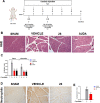Design, Synthesis, and Pharmacological Characterization of a Potent Soluble Epoxide Hydrolase Inhibitor for the Treatment of Acute Pancreatitis
- PMID: 37334504
- PMCID: PMC10350924
- DOI: 10.1021/acs.jmedchem.3c00831
Design, Synthesis, and Pharmacological Characterization of a Potent Soluble Epoxide Hydrolase Inhibitor for the Treatment of Acute Pancreatitis
Abstract
Acute pancreatitis (AP) is a potentially life-threatening illness characterized by an exacerbated inflammatory response with limited options for pharmacological treatment. Here, we describe the rational development of a library of soluble epoxide hydrolase (sEH) inhibitors for the treatment of AP. Synthesized compounds were screened in vitro for their sEH inhibitory potency and selectivity, and the results were rationalized by means of molecular modeling studies. The most potent compounds were studied in vitro for their pharmacokinetic profile, where compound 28 emerged as a promising lead. In fact, compound 28 demonstrated a remarkable in vivo efficacy in reducing the inflammatory damage in cerulein-induced AP in mice. Targeted metabololipidomic analysis further substantiated sEH inhibition as a molecular mechanism of the compound underlying anti-AP activity in vivo. Finally, pharmacokinetic assessment demonstrated a suitable profile of 28 in vivo. Collectively, compound 28 displays strong effectiveness as sEH inhibitor with potential for pharmacological AP treatment.
Conflict of interest statement
The authors declare no competing financial interest.
Figures











Similar articles
-
2-Oxaadamant-1-yl Ureas as Soluble Epoxide Hydrolase Inhibitors: In Vivo Evaluation in a Murine Model of Acute Pancreatitis.J Med Chem. 2020 Sep 10;63(17):9237-9257. doi: 10.1021/acs.jmedchem.0c00310. Epub 2020 Aug 25. J Med Chem. 2020. PMID: 32787085 Free PMC article.
-
Soluble Epoxide Hydrolase Pharmacological Inhibition Ameliorates Experimental Acute Pancreatitis in Mice.Mol Pharmacol. 2015 Aug;88(2):281-90. doi: 10.1124/mol.114.097501. Epub 2015 May 20. Mol Pharmacol. 2015. PMID: 25993999 Free PMC article.
-
Effects of soluble epoxide hydrolase deficiency on acute pancreatitis in mice.PLoS One. 2014 Nov 17;9(11):e113019. doi: 10.1371/journal.pone.0113019. eCollection 2014. PLoS One. 2014. PMID: 25402489 Free PMC article.
-
Soluble epoxide hydrolase inhibitors: an overview and patent review from the last decade.Expert Opin Ther Pat. 2022 Jun;32(6):629-647. doi: 10.1080/13543776.2022.2054329. Epub 2022 Apr 12. Expert Opin Ther Pat. 2022. PMID: 35410559 Review.
-
Soluble epoxide hydrolase: a novel target for the treatment of hypertension.Recent Pat Cardiovasc Drug Discov. 2006 Jan;1(1):67-72. doi: 10.2174/157489006775244227. Recent Pat Cardiovasc Drug Discov. 2006. PMID: 18221075 Review.
Cited by
-
MolBiC: the cell-based landscape illustrating molecular bioactivities.Nucleic Acids Res. 2025 Jan 6;53(D1):D1683-D1691. doi: 10.1093/nar/gkae868. Nucleic Acids Res. 2025. PMID: 39373530 Free PMC article.
-
5-methyl-2-carboxamidepyrrole-based novel dual mPGES-1/sEH inhibitors as promising anticancer candidates.Arch Pharm (Weinheim). 2025 Jan;358(1):e2400708. doi: 10.1002/ardp.202400708. Arch Pharm (Weinheim). 2025. PMID: 39692230 Free PMC article.
-
Neuroprotective Potential of Indole-Based Compounds: A Biochemical Study on Antioxidant Properties and Amyloid Disaggregation in Neuroblastoma Cells.Antioxidants (Basel). 2024 Dec 23;13(12):1585. doi: 10.3390/antiox13121585. Antioxidants (Basel). 2024. PMID: 39765912 Free PMC article.
-
Antitumor Mechanisms of Lycium barbarum Fruit: An Overview of In Vitro and In Vivo Potential.Life (Basel). 2024 Mar 21;14(3):420. doi: 10.3390/life14030420. Life (Basel). 2024. PMID: 38541744 Free PMC article. Review.
References
-
- Trindade-da-Silva C. A.; Clemente-Napimoga J. T.; Abdalla H. B.; Rosa S. M.; Ueira-Vieira C.; Morisseau C.; Verri W. A.; Montalli V. A. M.; Hammock B. D.; Napimoga M. H. Soluble epoxide hydrolase inhibitor, TPPU, increases regulatory T cells pathway in an arthritis model. FASEB J. 2020, 34, 9074–9086. 10.1096/fj.202000415R. - DOI - PMC - PubMed
Publication types
MeSH terms
Substances
LinkOut - more resources
Full Text Sources
Chemical Information
Medical

